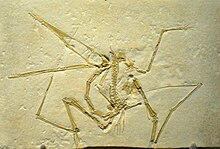Pterodactyloid
| Pterodactyloids Temporal range: Late Jurassic - Late Cretaceous, 162.7–66 Ma |
|
|---|---|
 |
|
| Cast of a Pterodactylus antiquus specimen, Carnegie Museum of Natural History | |
| Scientific classification | |
| Kingdom: | Animalia |
| Phylum: | Chordata |
| Class: | Reptilia |
| Order: | †Pterosauria |
| Clade: | †Caelidracones |
| Suborder: |
†Pterodactyloidea Plieninger, 1901 |
| Subgroups | |
|
|
| Synonyms | |
|
Dracochira Haeckel, 1895 |
|
Dracochira Haeckel, 1895
Pterodactyloidea (derived from the Greek words πτερόν (pterón, for usual ptéryx) "wing", and δάκτυλος (dáctylos) "finger" meaning "winged finger", "wing-finger" or "finger-wing") is one of the two traditional suborders of pterosaurs ("wing lizards"), and contains the most derived members of this group of flying reptiles. They appeared during the middle Jurassic Period, and differ from the basal (though paraphyletic) rhamphorhynchoids by their short tails and long wing metacarpals (hand bones). The most advanced forms also lack teeth. Many species had well developed crests on the skull, a form of display taken to extremes in giant-crested forms like Nyctosaurus and Tupandactylus. Pterodactyloids (specifically the family Azhdarchidae) were the last surviving pterosaurs when the order became extinct at the end of the Cretaceous Period, together with the non-avian dinosaurs and most marine reptiles.
"" is also a common term for pterodactyloid pterosaurs, though it can also be used to refer to Pterodactylus specifically or (incorrectly) to pterosaurs in general. Well-known examples of pterodactyloids include Pterodactylus, Dsungaripterus, Pteranodon, and Quetzalcoatlus.
In 2014, fossils from the Shishugou Formation of China were classified as the most basal pterodactyloid yet found, Kryptodrakon. At a minimum age of about 161 my, it is about 5 million years older than the oldest previously known confirmed specimens. Previously, a fossil jaw recovered from the Middle Jurassic Stonesfield Slate formation in the United Kingdom, was considered the oldest known. This specimen supposedly represented a member of the family Ctenochasmatidae, though further examination suggested it belonged to a teleosaurid stem-crocodilian instead of a pterosaur.
...
Wikipedia
